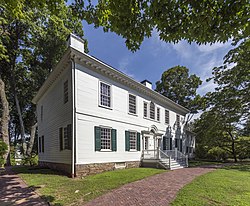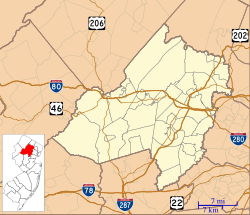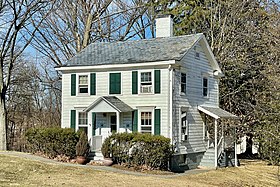
Morristown is a town and the county seat of Morris County, in the U.S. state of New Jersey. Morristown has been called "the military capital of the American Revolution" because of its strategic role in the war for independence from Great Britain. Morristown's history is visible in a variety of locations that collectively make up Morristown National Historical Park, the country's first National Historical Park.

James Hoban was an Irish-American architect, best known for designing the White House.

Morristown National Historical Park is a United States National Historical Park, headquartered in Morristown, New Jersey, consisting of four sites important during the American Revolutionary War: Jockey Hollow, Ford Mansion, Fort Nonsense, and Washington's Headquarters Museum.
Fort Motte was developed first as Mt. Joseph Plantation; it was commandeered in 1780 by the British and fortified as a temporary military outpost in what is now South Carolina during the American Revolutionary War. It was significant for its military use as a depot for their convoys between Camden and Charleston, which they occupied. Located along the Congaree River, it is roughly 90–95 miles from Charleston by 21st-century roadways. The British had fortified the big house and surrounds, and it became known as Fort Motte, after Rebecca Brewton Motte, who had been occupying it with her family. During the Patriot Siege of Fort Motte, the plantation mansion was set on fire. The British surrendered at this site.
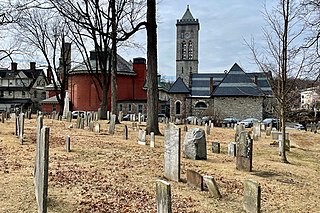
The First Presbyterian Church Cemetery is a historic churchyard cemetery of the First Presbyterian Church in Morristown, New Jersey, United States. The cemetery was added to the National Register of Historic Places, listed as a contributing property to the Morristown District, on October 30, 1973.

Jockey Hollow is the name for an area in southern Morris County, New Jersey farmed in the 18th century by the Wick, Guerin and Kemble families. The origin of the name is still uncertain, but was used as such at the time of the American Revolution. For most of the Revolutionary War, it was used by portions of Continental Army as a winter camp site, and it housed the main Continental Army during the "Hard Winter" of 1779–80, believed to be the harshest winter in recorded history.
Washington's Headquarters may refer to:

Henry William de Saussure was an American lawyer, state legislator and jurist from South Carolina who became a political leader as a member of the Federalist Party following the Revolutionary War. He was appointed by President George Washington as the 2nd Director of the United States Mint, was a co-sponsor of the legislation that established the South Carolina College which was to become the University of South Carolina and was given the title of Chancellor as a justice of the SC Equity Court, also known as chancery court. In this capacity he wrote and codified much of the state's equity law still in use today. He served as Intendant (Mayor) of Charleston while his son, William Ford de Saussure, likewise, served as Intendant (Mayor) of Columbia, SC.

Acorn Hall is an 1853 Victorian Italianate mansion located at 68 Morris Avenue in Morristown, Morris County, New Jersey. It was added to the National Register of Historic Places on April 3, 1973, for its significance in architecture. It serves as the headquarters of the Morris County Historical Society, which operates Acorn Hall as a historic house museum.

The Dey Mansion, located in modern-day Wayne, Passaic County, New Jersey, United States, and originally known as Bloomsburg Manor, played an integral role in the American Revolutionary War. Built by Col. Theunis Dey in the 1770s, it served as Washington's Headquarters on several occasions. Today, the Dey Mansion is currently open year-round with guided public tours Wednesday through Sunday.

Morristown Green, most commonly referred to as the Green, is a historical park located in the center of Morristown, New Jersey, United States. It has an area of two and a half acres and has in the past served as a military base, a militia training ground, and an area for public executions. It is now a public park in which many community events are held. It was added to the National Register of Historic Places, listed as a contributing property of the Morristown District, on October 30, 1973.

Rebecca Brewton Motte (1737–1815) was a plantation owner in South Carolina and townhouse owner in its chief city of Charleston. She was known as a patriot in the American Revolution, supplying continental forces with food and supplies for five years. By the end of the war, she had become one of the wealthiest individuals in the state, having inherited property from both her older brother Miles Brewton, who was lost at sea in 1775, and her husband Jacob Motte, who died in 1780.

Charles Alling Gifford was an American architect and a partner in the New York City firm of Gifford & Bates. He is best remembered for his resort hotels, but also designed houses, churches, and five armories for the New Jersey National Guard.
Juan de Miralles y Tizner was a Spanish arms dealer who became friends with George Washington during the American Revolutionary War. He supported the American cause financially, and served as a liaison between the colonists and the Spanish Crown.
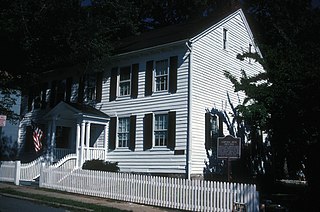
The Dr. Jabez Campfield House, also known as the Schuyler Hamilton House, is a historic, two-story, braced timber-frame colonial Georgian-style house and museum located at 5 Olyphant Place, Morristown, New Jersey.

Fosterfields, also known as Fosterfields Living Historical Farm, is a 213.4-acre (86.4 ha) farm and open-air museum at the junction of Mendham and Kahdena Roads in Morris Township, New Jersey. The oldest structure on the farm, the Ogden House, was built in 1774. Listed as the Joseph W. Revere House, Fosterfields was added to the National Register of Historic Places on September 20, 1973, for its significance in art, architecture, literature, and military history. The museum portrays farm life circa 1920.

Mary Crane Hone II was an American stage actress, campaign manager, political anti-war activist, and historical preservationist. She is best known for preserving Acorn Hall in Morristown, New Jersey.
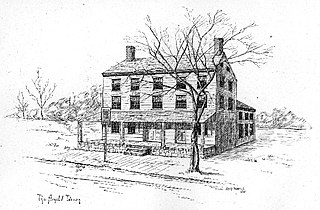
Jacob Arnold's Tavern, also known as the OldArnold Tavern and the Duncan House, was a "famous" historic tavern established by Samuel Arnold circa 1740. Until 1886, it was located in Morristown Green in Morristown, New Jersey. In 1777 it served as George Washington's headquarters during the Revolutionary War, and it was the site of Benedict Arnold's first trial in 1780. The National Park Service claims "Much of [Morris]town's social, political, and business life was conducted at Arnold's Tavern" during the Revolutionary era.

George Washington is an outdoor equestrian statue by the American sculptor Frederick Roth located near the Ford Mansion, Washington's Headquarters, in Morristown, New Jersey, United States. It was commissioned by philanthropist E. Mabel Clark to commemorate General George Washington's importance to the history of the city. The bronze sculpture was dedicated on October 19, 1928, the anniversary of the surrender of British General Charles Cornwallis at Yorktown in 1781.
